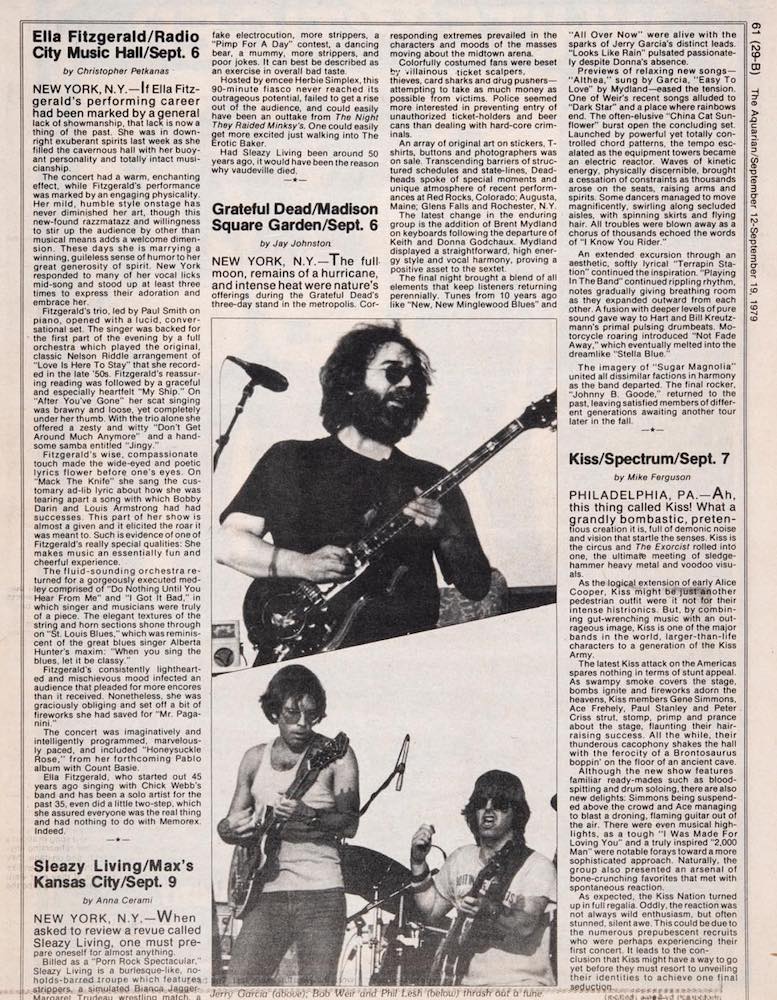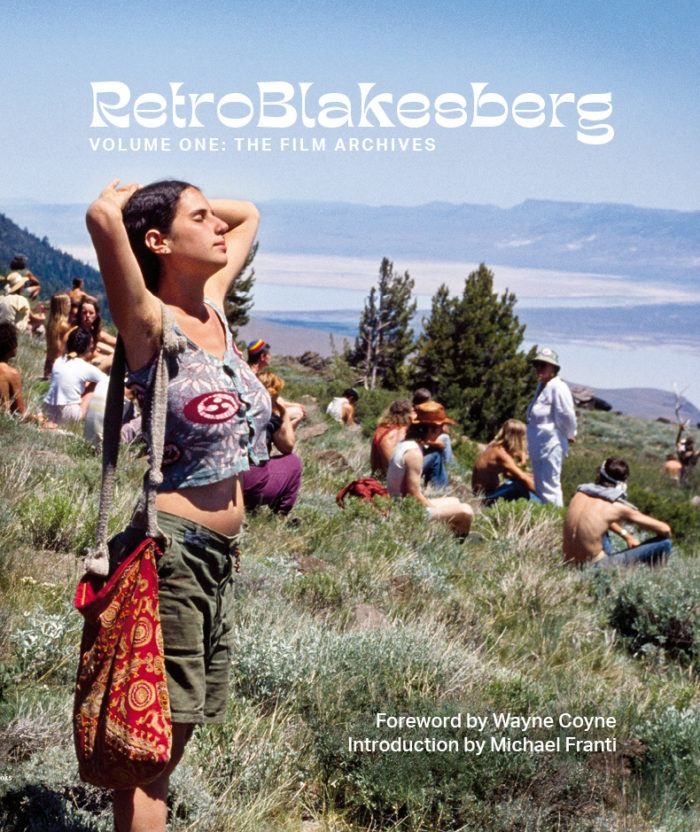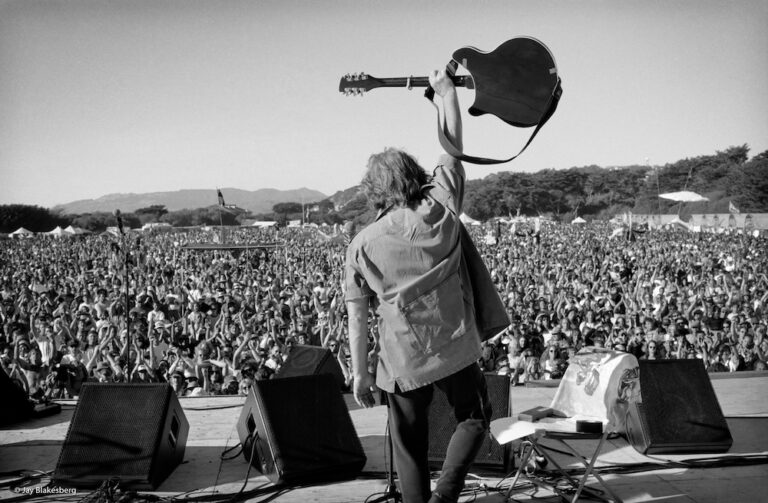Whether you decide to pick up his latest book or head out to his museum installation, the work of Jay Blakesberg is currently more accessible, tactile, and visceral than ever before.
As we get ready to welcome 2023, we are making a mental note of the things we want to carry into the new year. Hope, of course, being one of them, and the enchantment of memories made over the last 12 months. The work of Jay Blakesberg is one of them, too, but that’s something we’ll be holding onto not just now, but for years to come.
Blakesberg, a photographer, is one of many whose career stepping stones included a stint with The Aquarian – however he is most likely one of the only whose talents are both acknowledged and celebrated in a Smithsonian. New Jersey’s Morris Museum, a Smithsonian affiliate, opened an exhibit this past fall that features decade-spanning images captured by Blakesberg. His archives are extensive, and rightfully so being that his first published photos ran when he was just barely out of high school.
To put it simply, Jay Blakesberg got behind the lens of his father’s camera when he was 17, took some live shots of the Grateful Dead, and we published them alongside a concert review.
We’ll let Blakesberg himself put it more elaborately, telling the true tale of how he got his foot in the concert photography and entertainment journalism door. “I [started] as a high school kid in Clark, New Jersey, going to concerts at the Capitol Theater in Passaic, New Jersey. As a teenager, I was looking for that inspiration, looking for that spark that will get me going. When I was 17, I met a guy in Colorado at a Grateful Dead concert in the third week in August of 1979. I had just graduated from high school and he said he was going to be reviewing a Grateful Dead concert in another week-and-a-half for The Aquarian Weekly. Of course I knew it – we read The Aquarian every week. It was sort of our music bible of what was going on and where we were gonna go, what we were gonna do, and what concerts we were gonna see. There was no internet, so the only place you could find out about what was going on locally was the radio, which was more general metropolitan area. Not The Aquarian Weekly, though. We went and found The Aquarian every week and read it cover to cover… or at least what interested us, for sure. We looked and saw what was coming up at the various concert venues . So, I said, ‘Yeah, of course I would love to submit photos to The Aquarian for your article.’ He wrote a review. I took some photos. My photos were taken up in Rochester, New York on September 1, 1979 at this Grateful Dead concert. Those are the two photos that ran in The Aquarian, but the show he actually reviewed was a couple days later at Madison Square Garden. Because of the deadline, the magazine ended up using the photos from Rochester and so they used two of my photos. I got paid $7.50 for each photo for a total of $15. I was 17 years old and I was now a paid photographer that was published in print. Nowadays we’re published every two minutes – every 30 seconds – on social media. But back then, to be published in print was a huge deal. Also, to be published in print in The Aquarian? To me, that was like being published in the New York Times. That was super important.”

That wasn’t the end of Blakesberg’s stint with us, though. Nor was it the last time he snapped the Grateful Dead live in concert (at all). “A few months later, […] a review of a Grateful Dead Concert down in Philadelphia at the Spectrum was published and the magazine used one of my photos of Jerry Garcia in that article. Those were the only two times that I was published because of my work in The Aquarian.”
He goes on to tell this magnifcent story that original readers and music-loving locals will especially love. “The Capitol Theater was like the premier concert venue in New Jersey. Everybody played there. There were about 3,000 seats and bands that would play Madison Square Garden might also come and play The Capitol. They might play 20,000 people at the Garden then a quarter of that at The Capitol. I was there at all [the shows I liked] and Jerry Garcia and The Dead played there, obviously, numerous times. One time, I went to a show there – I believe was Jorma Kaukonen, the guitar player in a band called Hot Tuna and in Jefferson Airplane – and they had a costume contest. I won! The Aquarian Weekly ran the photo of me up on stage. It was like a hippie sixties costume. I was 18 and that was the other time that I was actually in The Aquarian, which is kind of funny. Those were the beginning moments of this thing: getting published and getting paid by The Aquarian. And, you know, a few dollars was a big deal for a 17 year old kid back then.”
It’s not everyday that you’re flipping through archives and piecing together old film (even if your content is as exhilarating as Blakesberg’s). It’s not everyday that you’re living through a global pandemic either (let alone quarantined and on lockdown). When COVID-19 rolled into town and shifted the lives of the world at large, Blakesberg was approached by his daughter, Ricki, about an easy at-home project: an Instagram account. Not only would this be a way to keep busy and share a multitude of rocking visuals with the masses, but it would be a trip down memory lane for a father and daughter.
“I have a daughter who is 26 years old, and at the very beginning of the pandemic, April of 2020, she came to me and said, ‘I wanna do a new Instagram page for you called Retro-Blakesberg. It’s only gonna be photographs that you shot on film.’ Here’s my daughter who grew up with a cell phone in her hand and an iPad on her lap who resonated with my film photographs. I haven’t shot film since 2008 – that’s the last time I shot film. That is 15 years now of just shooting digital photographs. She sort of forced me to go back and revisit all of these photographs, and one of the things that was important for her was to find photographs that resonated with people that were around her age and to introduce them to my work. A lot of people know of me as a Grateful Dead photographer. A lot of people that follow me on my Instagram page, which is just called jayblakesberg, are older people. They’re deadheads, they’re people that see me at concerts and are aware of what I do. They’re maybe not aware that in the late eighties and early nineties, which at this point now is 30 to 35 years ago, I was shooting the birth of alternative rock.”
It seems like everyone from the eighties and nineties and beyond took the stage and/or sat for our iconic alum: Red Hot Chili Peppers, Green Day, Björk, Aretha Franklin, and even pre-Dave Grohl-era Nirvana. If that’s not insane and inspirational, what is? Well, Blakesberg will tell you.
“I was shooting the Chili Peppers. I was shooting Nirvana. I was shooting Pearl Jam. I was shooting Soundgarden. I was shooting Jane’s Addiction, the Flaming Lips – Wayne Coyne of the Flaming Lips wrote the forward for the new book. I first photographed Wayne in 1989. We’ve been friends ever since. That’s 33 years ago, right? So if you were 25 years old when we went to those Flaming Lips concerts, you’re 58 years old today, which is pretty mind boggling. My daughter wanted to reintroduce this work to a younger generation of people, though, and a lot of the people that follow this new account are younger people. […] Ricki has done a great job of building this following of people that are the [new] generation.”
This turned into more than just a familial project – it became Retroblakesberg Volume One: The Film Archives. The photographer’s original work has spawned some 15 books already, coffee table and otherwise, but something about Retroblakesberg, No. 16, felt even more special. Maybe it’s because it focused on analog film only, hard and metal and nothing digital or technologically modern, or maybe it’s because it was curated alongside his daughter, whose voice is laced throughout the book, effortlessly weaving eras of life and pop culture through the pictures.
On the topic of unpacking all of that and evoking inspiration more than nostalgia, Blakesberg tells us, “It’s definitely a profound experience. I have shot a lot – at this point I’ve got almost 45 years of pop culture history documented on film and now digital.”
“As we sort of dug into all of this stuff, she really started to point out that kids her age still listen to those bands. The Chili Peppers just finished doing a big tour – worldwide and in stadiums. When I shot them, it was in nightclubs and small theaters and they were the opening act. This was ’87 and ’88 and ’89. They were playing to 500 people or a thousand people when I first started shooting them. Also, just the way that they dressed and how they looked on stage and the attitude of the time before there was cell phone technology, before there was Instagram and TikTok and Snapchat, is captured. My daughter wanted the people today that still listen to that music or inspired by that music to see these photographs because it’s all about inspiration. Whether you’re 50 or 60 years old – I’m 60 years old and my daughter is 26 – you still wanna look for stuff that inspires you. If it’s a badass photo of the Red Hot Chili Peppers when they were 25 years old and t inspires you as a 25 year old kid today, then that’s how it should be. That was Ricki’s position on this and what she kept pointing out to me. ‘Look at what they’re wearing. Oh my God, look at what Björk’s wearing! Look at what this! Look at the stickers! Look at the snacks that are on the table in front of them in the backstage dressing room!’ All of that stuff helps tell a story. When I sort of realized what she was going for and how she was mapping it out, it occurred to me that this was the chance for me to do this as my visual autobiography.”
“The book is separated out by decades. There’s the seventies, which is stuff that I started shooting in high school. Then there is the eighties, nineties, and 2000s up until 2008. At the beginning of each one of those decades, I wrote a 2,500 word essay about where I was at in that pop culture landscape at that time. People are always saying, ‘Oh my God, you have such an interesting story. You should write an autobiography. You should write your story.’ I’m not the kind of guy that’s going to sit down and type out 300 pages. […] This gave me an opportunity to sort of tell my story in context to where I was with my camera, but also in context to where we were in terms of pop culture and rock and roll, and how those decades went on and changed.”

And to think that a Smithsonian-affiliated museum picked up on all of this, was enchanted by the energy captured by the artists both in front of the camera and behind it, and turned it into an interactive, captivating exhibit? It’s not unbelievable at all, but the fact that said museum is in the photographer’s home state? Where his career took off and he honed his craft so diligently? That is something special, marvelous, and borderline serendipitous. We know that we’re proud of the cameraman and his 44-year-long profession – his calling, if you will, but what does Blakesberg himself think?
Naturally, he’s over-the-moon. A journey like his captured and snapped and shot and shared with fans, friends, and familiar faces is thrilling and almost overwhelming. The artists you love, the songs you have memorized, the shows you experienced FOMO for – Jay Blakesberg had you covered. Visually, at least – and he still does. “Here we are, almost 45 years later, and the Morris Museum, 20 miles away from where I grew up, comes and says, ‘We wanna do a career retrospective of your work on film from 1978 to 2008.’ That tear sheet from The Aquarian Weekly is in that museum exhibit. The story about me shooting those pictures for The Aquarian and getting published are didactics on the wall with captions and texts and glass cases and pictures of me when I was a teenager, pictures of bands that I shot, and pictures of my friends that I shot in my bedroom hanging out or on the streets or on the bleachers at the high school causing trouble and being stupid young kids. That’s where it started and now this is where it’s come to. It hasn’t ended, because I’m not done yet, but this is where it’s at now. It’s this arc of my life and it’s fairly remarkable that it’s on exhibit at the Morris Museum, which is also the only Smithsonian affiliate in the state of New Jersey. This is like the real deal. This is a big huge thing for somebody that comes from New Jersey, born in Elizabeth, grew up in Clark, went to high school in Clark.”
“I really, really loved photography in high school. I started taking pictures when I was 16 years old. I think I would’ve continued on that path… I really didn’t become a ‘professional’ photographer until the mid-eighties, so there we seven, eight, nine years later where I was like, ‘Ok, I’m now an adult. I’m out of college. Now is the time where I need to figure out how to make a living and I think I wanna try and do it as a photographer.’ That was about ’86, but getting those images published for me in ’79 in The Aquarian was huge in terms of generating that spark and turning it into a little bit of a flame of being truly passionate about photography. It’s those little tiny things that happen that give you the inspiration to keep you going, so without those things – like being published in The Aquarian not once, but twice with my work – makes a huge difference. It makes you believe in yourself, it makes you believe that your work is good enough to be published, and it makes you believe you’re good enough to keep trying to do it. Essentially, when you’re 17, you don’t know what you’re gonna do or what you wanna do. Occasionally you get someone who’s like, ‘I wanna be a doctor. I wanna be an astronaut.’ For me, and also I think for most kids in the 1970s, we didn’t have the internet to inform us. Our parents said, ‘You’re gonna go to college and you’re gonna get an education. You can’t be an artist, you can’t be a photographer – you need to go on to Wall Street, you need to be a lawyer or a doctor. Whatever it might be, you need to be a professional.’ We just wanted to go see concerts and smoke weed because we were kids and that’s just all we knew, so those building blocks, no matter how small, are important in your formation.”
TO PURCHASE THE BOOKS AND WORKS OF JAY BLAKESBERG, CLICK HERE! VISIT HIS EXHIBIT AT THE MORRIS MUSEUM – IT RUNS THROUGH FEBRUARY 5, 2023! FOR DETAILS, HEAD OVER TO THE MUSEUM’S WEBSITE.



 (@retroblakesberg)
(@retroblakesberg)